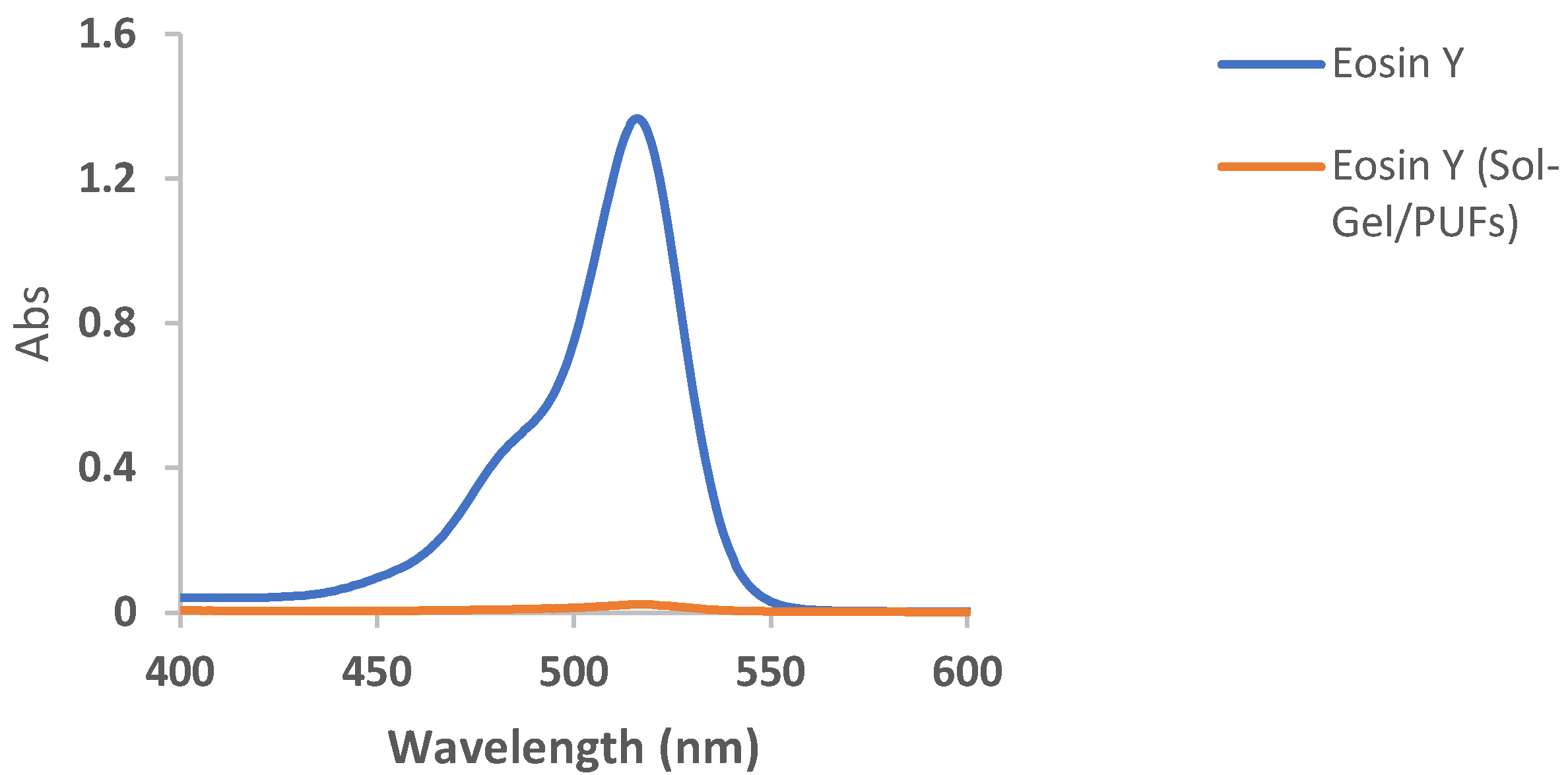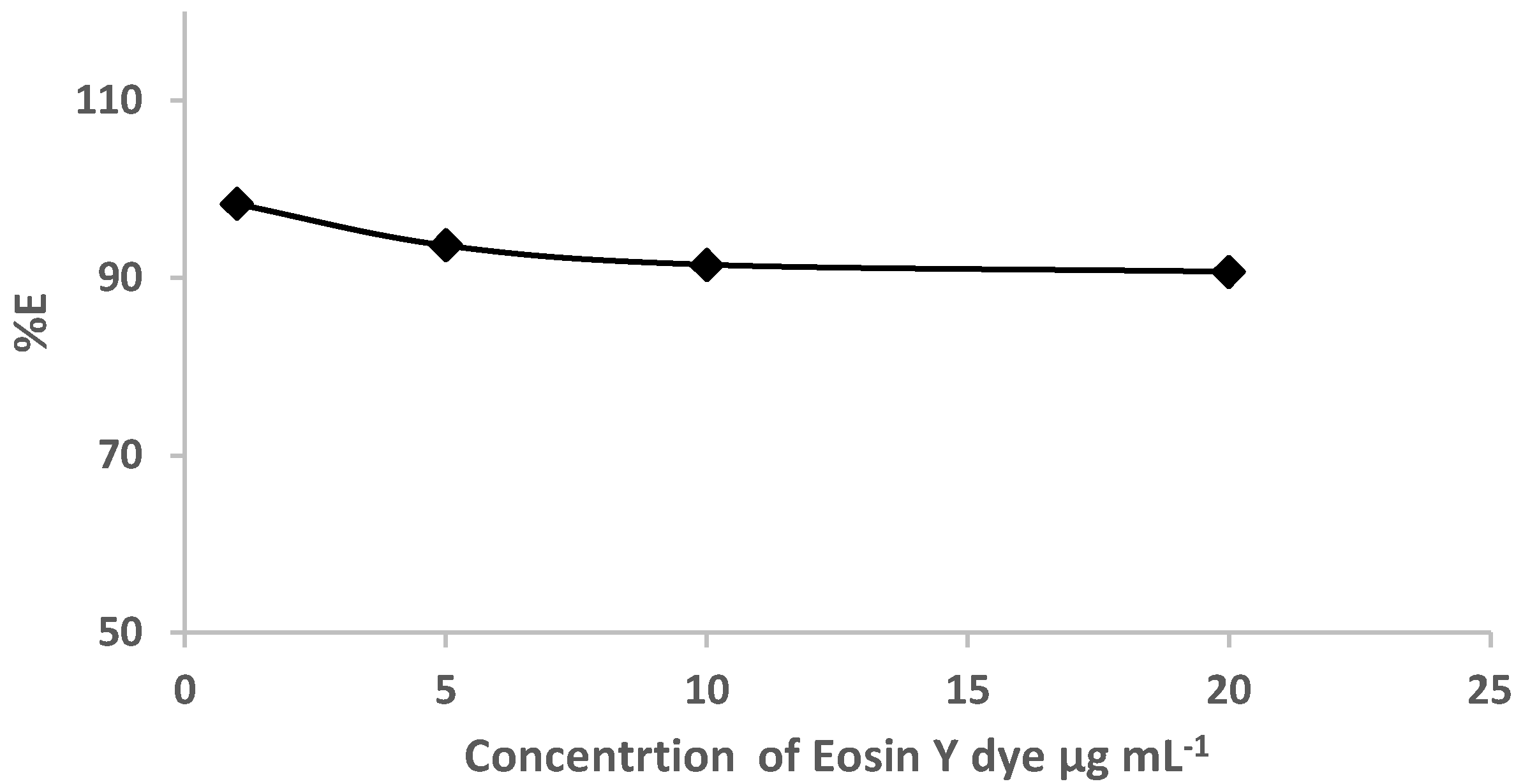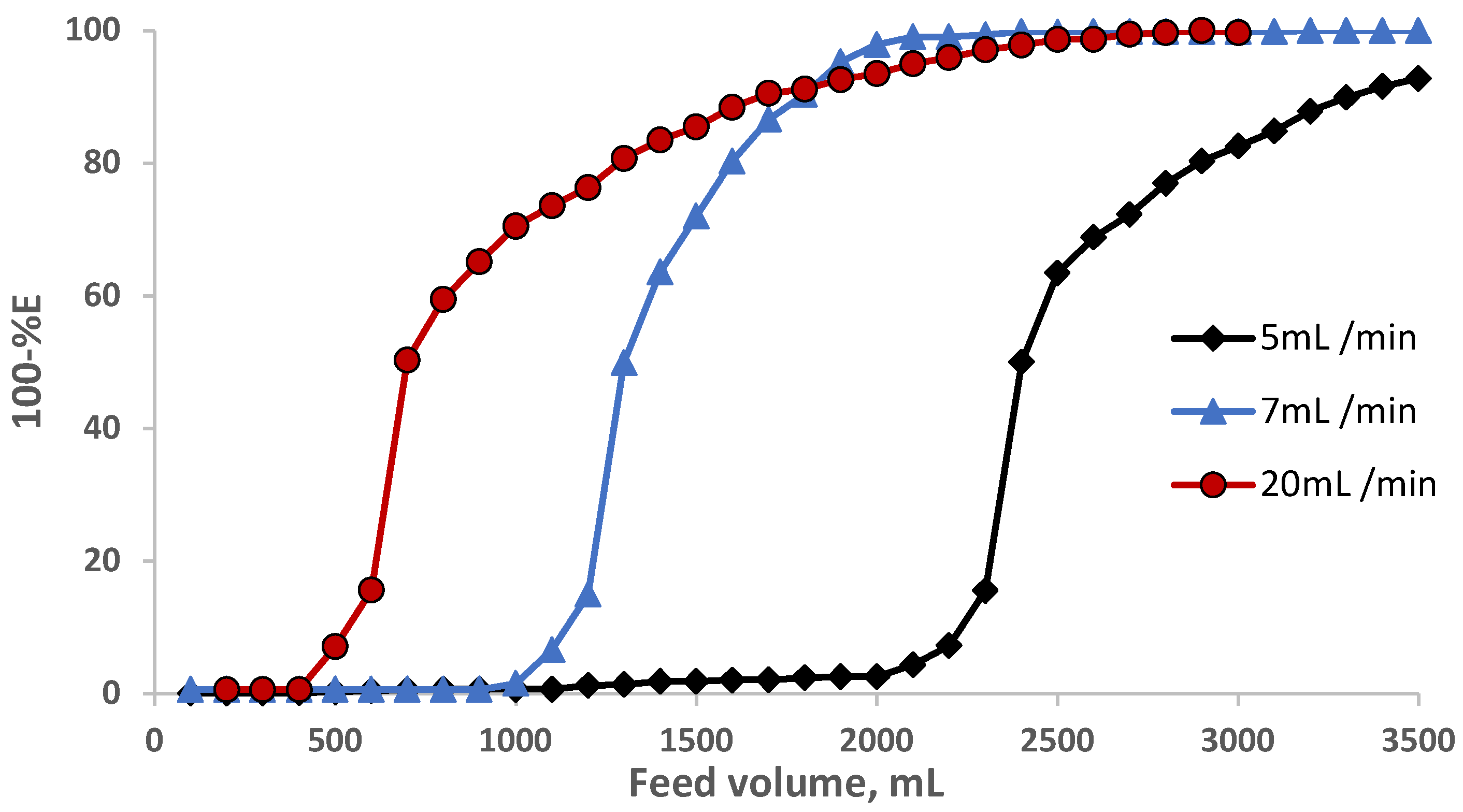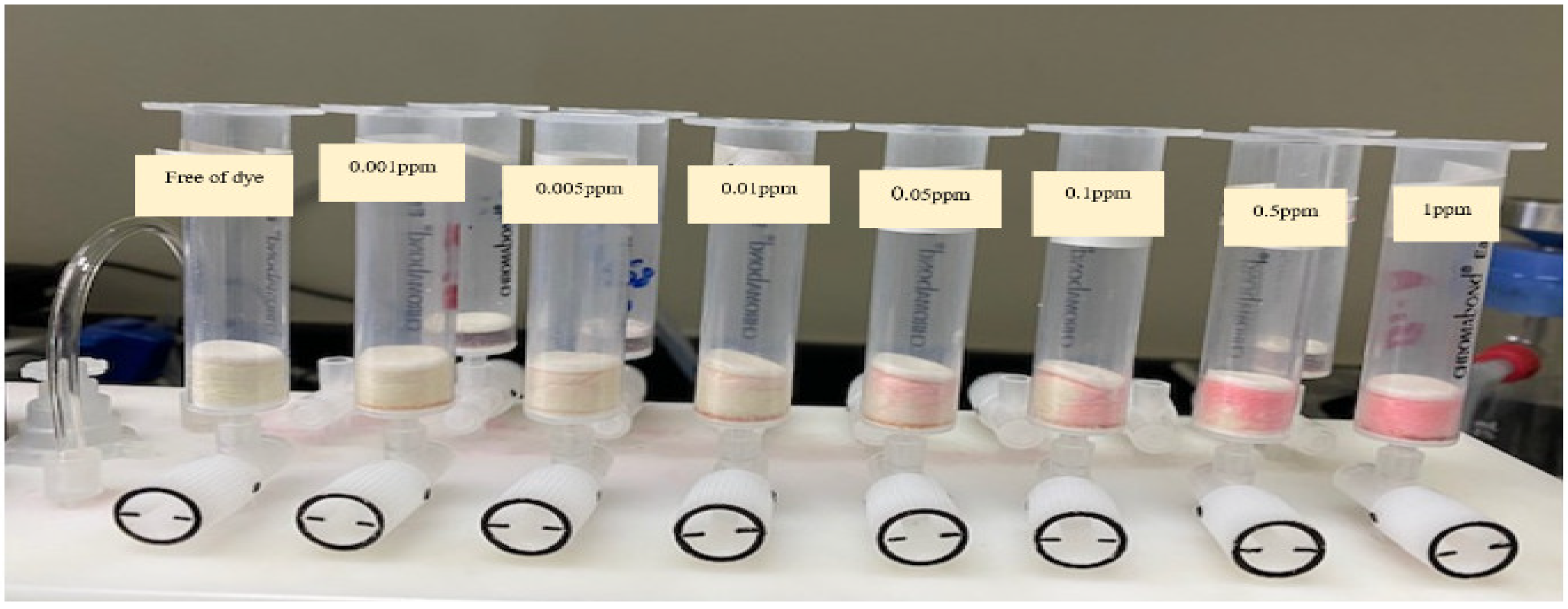Sol-Gel Functionalized Polyurethane Foam-Packed Mini-Column as an Efficient Solid Extractor for the Rapid and Ultra-Trace Detection of Textile Dyes in Water
Abstract
:1. Introduction
2. Results and Discussion
2.1. Preliminary Study
2.2. Characterization of Sol-Gel
2.3. Chromatographic Separation
2.4. Analytical Applications
2.5. Reusability of the Established Solid Platform
3. Conclusions
4. Materials and Methods
4.1. Materials and Reagents
4.2. Instrumentation
4.3. Preparation of Sol-Gel Materials
4.4. Synthesis of Sol-Gel Functionalized Polyurethane Foams (d-µ SPME)
4.5. Recommended Procedures
4.5.1. Preparation of the Min-Columns
4.5.2. Mini-Column Assays
4.5.3. Breakthrough (S-Shaped) Capacity Curve Method
4.5.4. Chromatogram (Gluenkauf Method)
4.6. Analytical Applications: Rretention and Recovery of EY Dye by Flow (Mini-Column)
Supplementary Materials
Author Contributions
Funding
Institutional Review Board Statement
Informed Consent Statement
Data Availability Statement
Acknowledgments
Conflicts of Interest
References
- Tran, H.N.; Nguyen, D.T.; Le, G.T.; Tomul, F.; Lima, E.C.; Woo, S.H.; Sarmah, A.K.; Nguyen, H.Q.; Nguyen, P.T.; Nguyen, D.D.; et al. Adsorption mechanism of hexavalent chromium onto layered double hydroxides-based adsorbents: A systematic in-depth review. J. Hazard. Mater. 2019, 373, 258–270. [Google Scholar] [CrossRef] [PubMed]
- Saigl, Z.; Tifouti, O.; Alkhanbashi, B.; Alharbi, G.; Algamdi, H. Chitosan as adsorbent for removal of some organic dyes: A review. Chem. Pap. 2023, 77, 2363–2405. [Google Scholar] [CrossRef]
- Annan, E.; Arkorful, G.K.; Konadu, D.S.; Asimeng, B.; Konadu, D.S.; Bernard Asimeng, B.; David Dodoo-Arhin, D.; Egblewogbe, M. Synthesis and Characterization of Hydroxyapatite-(HAP-) Clay Composites and Adsorption Studies on Methylene Blue for Water Treatment. J. Chem. 2021, 2021, 3833737. [Google Scholar] [CrossRef]
- Abdul Mubarak, N.S.; Chua, T.W.; Sabar, S. Immobilized Fe-loaded chitosan film for methyl orange dye removal: Competitive ions, reusability, and mechanism. J. Polym. Environ. 2020, 29, 1050–1062. [Google Scholar] [CrossRef]
- World Health Organization. Guidelines for Drinking-Water Quality; WHO: Geneva, Switzerland, 1996; p. 2. [Google Scholar]
- Babazadeh, M.; Abolghasemi, H.; Esmaeili, M.; Ehsani, A.; Alireza Badiei, A. Comprehensive batch and continuous methyl orange removal studies using surfactant modified chitosan-clinoptilolite composite. Sep. Purif. Technol. 2021, 267, 118601. [Google Scholar] [CrossRef]
- Azadfara, M.; Tahermansourib, H.; Qomi, M. Application of the graphene oxide/chitosan nanocomposite in the removal of methyl orange from aqueous solutions: A mechanism study. Indian J. Chem. 2020, 60, 209–219. [Google Scholar]
- Singh, R.; Sinha, M.K.; Purkait, M.K. Stimuli responsive mixed matrix polysulfone ultrafiltration membrane for humic acid and photocatalytic dye removal applications. Sep. Purif. Technol. 2020, 250, 117247. [Google Scholar] [CrossRef]
- Joseph, J.; Radhakrishnan, R.C.; Johnson, J.K.; Joy, S.P.; Thomas, J. Ion-exchange mediated removal of cationic dye-stuffs from water using ammonium phosphomolybdate. Mater. Chem. Phys. 2020, 242, 122488. [Google Scholar] [CrossRef]
- Mariah, G.K.; Pak, K.S. Removal of brilliant green dye from aqueous solution by electrocoagulation using response surface methodology. Mater. Today Proc. 2020, 20, 488–492. [Google Scholar] [CrossRef]
- Deshannavar, U.B.; Singa, P.K.; Gaonkar, D.; Gayathri, A.; Patil, A.; Malade, L.V. Removal of acid violet 49 and acid red 88 dyes from aqueous solutions using advanced oxidation process. Mater. Today Proc. 2020, 24, 1011–1119. [Google Scholar] [CrossRef]
- Moghaddas, S.M.; Elahi, B.; Javanbakht, V. Biosynthesis of pure zinc oxide nanoparticles using quince seed mucilage for photocatalytic dye degradation. J. Alloys Compd. 2020, 821, 153519. [Google Scholar] [CrossRef]
- Shabaan, O.A.; Jahin, H.S.; Mohamed, G.G. Removal of anionic and cationic dyes from wastewater by adsorption using multiwall carbon nanotubes. Arab. J. Chem. 2020, 13, 4797–4810. [Google Scholar] [CrossRef]
- Beluci, N.D.; Mateus, G.A.; Miyashiro, C.S.; Homem, N.C.; Gomes, R.G.; Fagundes-Klen, M.R.; Bergamasco, R.; Vieirad, A.M.S. Hybrid treatment of coagulation/flocculation process followed by ultrafiltration in TIO2-modified membranes to improve the removal of reactive black 5 dye. Sci. Total Environ. 2019, 664, 222–229. [Google Scholar] [CrossRef]
- Chandanshive, V.V.; Kadam, S.K.; Khandare, R.V.; Kurade, M.B.; Jeon, B.H.; Jadhav, J.P.; Govindwar, S.P. In situ phytoremediation of dyes from textile wastewater using garden ornamental plants, effect on soil quality and plant growth. Chemosphere 2018, 210, 968–976. [Google Scholar] [CrossRef] [PubMed]
- Tabesh, S.; Davar, F.; Loghman-Estarki, M.R. Preparation of α-Al2O3 nanoparticles using modified Sol-gel method and its use for the adsorption of lead and cadmium ions. J. Alloys Compd. 2018, 730, 441–449. [Google Scholar] [CrossRef]
- Rocío-Bautista, P.; Pacheco-Fernández, I.; Pasán, J.; Pino, V. Are metal-organic frameworks able to provide a new generation of solid-phase microextraction coatings?—A review. Anal. Chim. Acta 2016, 939, 26–41. [Google Scholar] [CrossRef]
- Basie, R.B.; Orimoso, A.; Osinobi, A. Macedonian. J. Med. Sci. 2012, 15, 26–29. [Google Scholar]
- Pavlidis, M.; Stupp, T.; Naskar, R.; Cengiz, C.; Thanos, S. Retinal ganglion cells resistant to advanced glaucoma: A postmortem study of human retinas with the carbocyanine dye DiI. Investig. Ophthalmol. Vis. Sci. 2003, 44, 5196–5205. [Google Scholar] [CrossRef]
- Sasaki, Y.F.; Kawaguchi, S.; Kamaya, A.; Ohshita, M.; Kabasawa KIwama, K.; Taniguchi, K.; Tsuda, S. The comet assay with 8 mouse organs: Results with 39 currently used food additives. Mutat. Res. Genet. Toxicol. Environ. Mutagen. 2002, 519, 103–119. [Google Scholar] [CrossRef]
- Sun, J.M.; Henderson, R.F.; Marshall, T.C.; Cheng, Y.S.; Dutcher, J.S.; Pickrell, J.A.; Mauderly, J.L.; Hahn, F.F.; Banas, D.A.; Seiler, F.A.; et al. The inhalation toxicity of two commercial dyes: Solvent yellow 33 and solvent green 3. Fundam. Appl. Toxicol. 1987, 8, 358–371. [Google Scholar] [CrossRef]
- Borzelleca, J.F.; Capen, C.C.; Hallagan, J.B. Lifetime toxicity/carcinogenicity study of FD & C Red No. 3 (erythrosine) in rats. Food Chem. Toxicol. 1987, 25, 723–733. [Google Scholar] [PubMed]
- Baharak, R.; Ali, N. Biosorption of a textile dye (Eosin) by eucalyptus tree leaves biomass: Estimation of equilibrium, thermodynamic and kinetic parameters. Adv. Sci. Focus 2013, 1, 50–56. [Google Scholar]
- Ayati, A.; Ranjbari, S.; Tanhaei, B.; Sillanpää, M. Ionic liquid-modified composites for the adsorptive removal of emerging water contaminants: A review. J. Mol. Liq. 2019, 275, 71–83. [Google Scholar] [CrossRef]
- Karimi-Maleh, H.; Ayati, A.; Davoodi, R.; Tanhaei, B.; Karimi, F.; Malekmohammadi, S.; Jin, W.; Fu, L.; Sillanpää, M. Recent advances in using of chitosan-based adsorbents for removal of pharmaceutical contaminants: A review. J. Clean. Prod. 2021, 291, 125880. [Google Scholar] [CrossRef]
- Ghorai, S.; Sarkar, A.K.; Panda, A.B.; Sagar, P. Effective removal of Congo red dye from aqueous solution using modified xanthan gum/silica hybrid nanocomposite as adsorbent. Bioresour. Technol. 2013, 144, 485–491. [Google Scholar] [CrossRef]
- Pirkarami, A.; Olya, M.E. Removal of dye from industrial wastewater with an emphasis on improving economic efficiency and degradation mechanism. J. Saudi Chem. Soc. 2017, 21, S179–S186. [Google Scholar] [CrossRef]
- Robinson, T.; Geoff, M.M.; Marchant, R.; Nigam, P. Remediation of dyes in textile effluent: A critical review on current treatment technologies with a proposed alternative. Bioresour. Technol. 2001, 77, 247–255. [Google Scholar] [CrossRef]
- Bahrudin, N.N.; Nawi, M.A. Mechanistic of photocatalytic decolorization and mineralization of methyl orange dye by immobilized TiO2/chitosan-montmorillonite. J. Water Process Eng. 2019, 31, 100843. [Google Scholar] [CrossRef]
- Bahrudin, N.N.; Nawi, M.A.; Zainal, Z. Insight into the synergistic photocatalytic-adsorptive removal of methyl orange dye using TiO2/chitosan based photocatalyst. Int. J. Biol. Macromol. 2020, 165 Pt B, 2462–2474. [Google Scholar] [CrossRef]
- Hameed, B.H. Spent tea leaves: A new non-conventional and low-cost adsorbent for removal of basic dye from aqueous solutions. J. Hazard. Mater. 2009, 161, 753–759. [Google Scholar] [CrossRef]
- Kabir, A.; Furton, K.G. Novel Sol gel sorbents in sorptive microextraction. In Analytical Microextraction Techniques, Bentham Solid-Phase Microextraction-Based Sol-Gel Technique; Electronic Book; Valcárcel, M., Cárdenas, S., Lucena, R., Eds.; Bentham Science Publishers: Sharjah, United Arab Emirates, 2016; Chapter 2; ISBN 978-1-68108-379-7. [Google Scholar] [CrossRef]
- Baral, A.; Das, D.P.; Minakshi, M.; Ghosh, M.K.; Padhi, D.K. Probing Environmental Remediation of RhB Organic Dye Using α-MnO2 under Visible- Light Irradiation: Structural, Photocatalytic and Mineralization Studies. Chem. Sel. 2016, 1, 4277–4285. [Google Scholar]
- Amiri, A. Solid-phase microextraction-based sol-gel technique. Trends Anal. Chem. 2016, 75, 57–74. [Google Scholar] [CrossRef]
- Kabir, A.; Furton, K.G.; Malik, A. Innovations in sol-gel microextraction phases for solvent—Free sample preparation in analytical chemistry. Trends Anal. Chem. 2013, 45, 197–218. [Google Scholar] [CrossRef]
- El-Shahawi, M.S. Retention and separation of some organic water pollutants with unloaded and tri-n-octylamine loaded polyester-based polyurethane foams. Talanta 1994, 41, 1481–1488. [Google Scholar] [CrossRef]
- Aneta, J.S.; Moreira, G.C.; Silva, G.J.; Reis, C.; Reis, E.L. Use of polyurethane foams for the removal of the Direct Red 80 and Reactive Blue 21dyes in aqueous medium. Desalination 2011, 281, 55–60. [Google Scholar]
- Han, J.; Cao, Z.; Qiu, W.; Gao, W.; Hu, J.; Xing, B. Probing the specificity of polyurethane foam as a ‘solid-phase extractant’: Extractability-governing molecular attributes of lipophilic phenolic compounds. Talanta 2017, 172, 186–198. [Google Scholar] [CrossRef]
- Jalili, V.; Barkhordari, A.; Ghiasvand, A. A comprehensive look at solid-phase microextraction technique: A review of reviews. Microchem. J. 2020, 152, 104319. [Google Scholar] [CrossRef]
- Murtada, K. Trends in nanomaterial-based solid-phase microextraction with a focus on environmental applications—A review. Trends Environ. Anal. Chem. 2020, 25, e00077. [Google Scholar] [CrossRef]
- Ghorbani, M.; Aghamohammadhassan, M.; Chamsaz, M.; Akhlaghi, H.; Pedramrad, T. Dispersive solid phase microextraction. TrAC Trends Anal. Chem. 2019, 118, 793–809. [Google Scholar] [CrossRef]
- Cullen, M.; Morshmmad, M.; O’Sullivan, M.; Duffy, B.; Oubaha, M. Correlation between the structure and the anticorrosion barrier properties of hybrid sol-gel coatings: Application to the protection of AA 2024-T3 alloys. J. Sol-Gel Sci. Technol. 2017, 82, 801–816. [Google Scholar] [CrossRef]
- Oubaha, M. Sol-Gel Strategies for Hybrid materials. In World Scientific Reference of Hybrid Materials; World Scientific: Singapore, 2019; ISBN 9789813270480. [Google Scholar]
- Huang, X.; Mao, X.Y.; Bu, H.T.; Yu, X.Y.; Jian, G.B.; Zeng, M.H. Chemical modification of chitosan by tetraethylenepentamine and adsorption study for anionic dye removal. Carbohydr. Res. 2011, 346, 1232–1240. [Google Scholar] [CrossRef] [PubMed]
- Huang, X.Y.; Bin, J.P.; Bu, H.T.; Jiang, G.B.; Zeng, M.H. Removal of anionic dye Eosin Y from aqueous solution using ethylenediamine modified chitosan. Carbohydr. Polym. 2011, 84, 1350–1356. [Google Scholar] [CrossRef]







| Eosin Y Added, μg/mL | Eosin Y Found, μg/mL | Recovery % |
|---|---|---|
| 1.0 | 1.4 ± 0.4 | 104 ± 0.4 |
| 0.5 | 0.52 ± 0.2 | 102 ± 0.2 |
| 0.1 | 0.1 ± 0.2 | 100 ± 4 |
| 0.05 | 0.051 ± 0.04 | 100 ± 4 |
| 0.01 | 0.01 | 100 ± 4 |
| 0.005 | nd. | nd. |
| 0.001 | nd. | nd. |
| Sample | Eosin Y Dye Added, μg/mL | Eosin Y Dye Found, μg/mL | Recovery, % |
|---|---|---|---|
| Tap water | 20 | 19.86 ± 0.01 | 99.31 ± 0.1 |
| 10 | 9.36 ± 0.01 | 93.65 ± 0.2 | |
| 5 | 4.604 ± 0.01 | 92.08 ± 0.01 |
| Sample | Eosin Y Dye Added, μg/mL | Eosin Y Dye Found, μg/mL | Recovery, % |
|---|---|---|---|
| Tap water | 5 | 4.94 ± 0.2 | 98.94 ± 0.1 |
| 0.5 | 0.499 ± 0.01 | 99.8 ± 0.1 | |
| 0.1 | 0.1 ± 0.01 | 100 ± 0.1 | |
| 0.05 | 0.05 ± 0.01 | 100 ± 0.01 | |
| Sea water | 5 | 5.301 ± 0.021 | 106.02 ± 1.02 |
| 0.5 | 0.498 ± 0.01 | 99.6 ± 0.1 | |
| 0.1 | 0.1 ± 0.01 | 100 ± 0.1 | |
| 0.05 | 0.05 ± 0.01 | 100 ± 0.01 | |
| Wastewater | 5 | 4.602 ± 0.01 | 92.04 ± 0.26 |
| 0.5 | 0.497 ± 0.01 | 99.4 ± 0.1 | |
| 0.1 | 0.1 ± 0.01 | 100 ± 0.01 | |
| 0.05 | 0.05 ± 0.01 | 100 ± 0.01 |
Disclaimer/Publisher’s Note: The statements, opinions and data contained in all publications are solely those of the individual author(s) and contributor(s) and not of MDPI and/or the editor(s). MDPI and/or the editor(s) disclaim responsibility for any injury to people or property resulting from any ideas, methods, instructions or products referred to in the content. |
© 2023 by the authors. Licensee MDPI, Basel, Switzerland. This article is an open access article distributed under the terms and conditions of the Creative Commons Attribution (CC BY) license (https://creativecommons.org/licenses/by/4.0/).
Share and Cite
Ghandourah, M.A.; Orif, M.I.; Al-Farawati, R.K.; El-Shahawi, M.S.; Abu-Zied, R.H. Sol-Gel Functionalized Polyurethane Foam-Packed Mini-Column as an Efficient Solid Extractor for the Rapid and Ultra-Trace Detection of Textile Dyes in Water. Gels 2023, 9, 884. https://doi.org/10.3390/gels9110884
Ghandourah MA, Orif MI, Al-Farawati RK, El-Shahawi MS, Abu-Zied RH. Sol-Gel Functionalized Polyurethane Foam-Packed Mini-Column as an Efficient Solid Extractor for the Rapid and Ultra-Trace Detection of Textile Dyes in Water. Gels. 2023; 9(11):884. https://doi.org/10.3390/gels9110884
Chicago/Turabian StyleGhandourah, Mohammed A., Mohammad I. Orif, Radwan K. Al-Farawati, Mohammad S. El-Shahawi, and Ramadan H. Abu-Zied. 2023. "Sol-Gel Functionalized Polyurethane Foam-Packed Mini-Column as an Efficient Solid Extractor for the Rapid and Ultra-Trace Detection of Textile Dyes in Water" Gels 9, no. 11: 884. https://doi.org/10.3390/gels9110884
APA StyleGhandourah, M. A., Orif, M. I., Al-Farawati, R. K., El-Shahawi, M. S., & Abu-Zied, R. H. (2023). Sol-Gel Functionalized Polyurethane Foam-Packed Mini-Column as an Efficient Solid Extractor for the Rapid and Ultra-Trace Detection of Textile Dyes in Water. Gels, 9(11), 884. https://doi.org/10.3390/gels9110884






